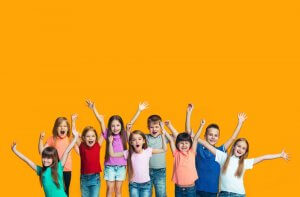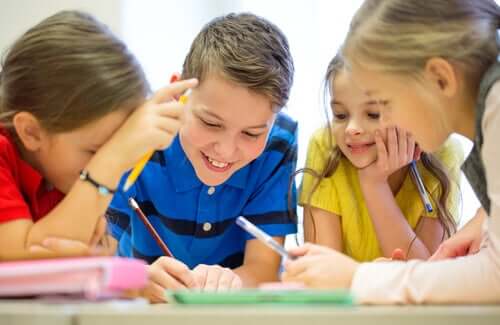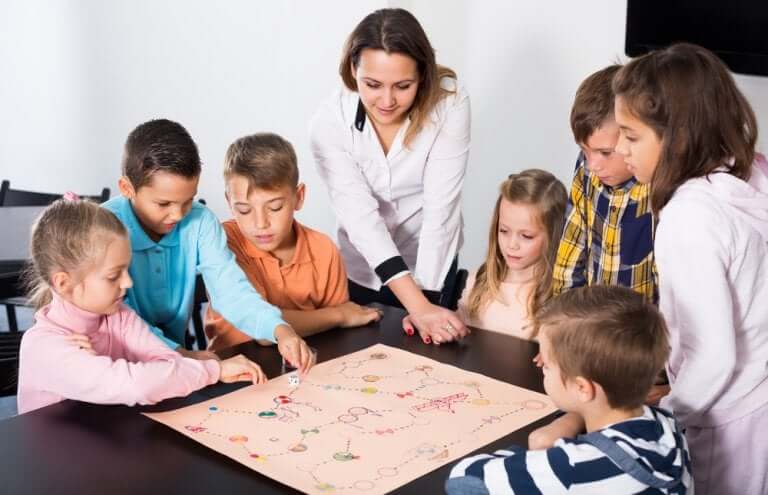Group Dynamics in Primary Education


Written and verified by the pedagogue and trainer María Matilde
To better understand group dynamics in primary education, we must first consider the characteristics that define a group.
A group refers two or more people, or a group of people, who act according to the same norms, values, and objectives, which are necessary for the common good of the group and for the pursuit of its goals. Thus, there are many types of groups, each with specific structures, tasks, and activities.
A group of primary school pupils, in the context of a school, is a type of social group that shares specific norms, objectives and tasks. So, how can we improve the functioning of that group? And in what way?
Group dynamics
Group dynamics are also known as group dynamics techniques. They refer to systemized means, or applied procedures, which aim to organize the group and develop how it works.
They’re very motivating techniques that, when applied to the groups, can stimulate how they work together. In this context, they’ll help all the group members to develop their learning. At the same time, they also work their potential and develop their effectiveness.

In this way, if a group uses these dynamics, then they’ll be able to achieve their objectives, and be more productive. In addition to that, they’ll achieve greater group cohesion and satisfaction.
Then, depending on the technique or dynamic put into play and on the specific characteristics of the group, one can work on learning related to the socialization, communication, and participation of group members.
At the same time, you can work on learning related to the development of creativity, responsibility and autonomy with the group’s own tasks. In addition, you can help with the resolution of conflicts and any problems that may arise within the group.
Group dynamics in primary education
Working with group dynamics in primary education is a way to motivate students and help them develop meaningful learning. At the same time, they learn norms and values, and develop responsible and respectful behavior, as well as solidarity.
So, to put it into practice you’ll need to work with and for the group on its dynamics. You’ll use techniques, activities, and games that will help to create greater well-being and balance within the group.
Some interesting group dynamics in primary education…
6 thinking hats
This is a group dynamic that consists of adopting a specific thought and attitude towards a problem. It all depends on the color of the hat that you’re wearing. The six styles of thinking represented by each hat are:
- White: A practical thought focused on the available data.
- Red: With this hat, we observe the problems using intuition, feelings, and emotions.
- Black: This is the thought of judgment and caution. In addition, it’s a thought that highlights the negative aspects of the subject matter.
- Yellow: Using this hat will focus on positive thinking that will help us see why something will work well and what the benefits may be.
- Green: This is the color of creativity; it’s a thought that brings new, unusual, and original ideas.
- Blue: This color inspires thoughts that control how you manage the thinking process. It’s in charge of summarizing everything that has been said in the group discussion. It will also aid in finding conclusions.
The aim of this dynamic is to facilitate the resolution and analysis of a problem. It takes into account that there are different points of view and perspectives.
Brainstorming
This is a creative thinking technique that’s used to encourage participation and to get more and better original ideas and information on a particular topic. It may even be used for the development of a project or team. In primary education an example could be “Cultural activities to be developed during Easter.”
In this way, all students contribute their ideas and opinions about what can be done. Someone in the group writes all the suggestions down, and on subsequent days they can flesh out the ideas further. Eventually, they’ll decide on the best way forward and plan and organize the project to its completion.

Symposium
This is a group dynamic that develops individual potentialities and, in turn, promotes cooperative work and communication. It consists of a pooling or “symposium” on different aspects of the same topic, i.e. providing information rather than defending a position.
In primary education, the children can use it to share their knowledge with the rest of their classmates, after having learned about the corresponding topic in that day’s lessons in class.
Each student can individually describe and list the information and knowledge that they’ve learned throughout that day. Then, later on, the teacher can organize a meeting in which the whole class comes together to share what they’ve learned.
In this way, the students will have the chance to find out other elements, information, or points of view that they hadn’t thought of individually.
To better understand group dynamics in primary education, we must first consider the characteristics that define a group.
A group refers two or more people, or a group of people, who act according to the same norms, values, and objectives, which are necessary for the common good of the group and for the pursuit of its goals. Thus, there are many types of groups, each with specific structures, tasks, and activities.
A group of primary school pupils, in the context of a school, is a type of social group that shares specific norms, objectives and tasks. So, how can we improve the functioning of that group? And in what way?
Group dynamics
Group dynamics are also known as group dynamics techniques. They refer to systemized means, or applied procedures, which aim to organize the group and develop how it works.
They’re very motivating techniques that, when applied to the groups, can stimulate how they work together. In this context, they’ll help all the group members to develop their learning. At the same time, they also work their potential and develop their effectiveness.

In this way, if a group uses these dynamics, then they’ll be able to achieve their objectives, and be more productive. In addition to that, they’ll achieve greater group cohesion and satisfaction.
Then, depending on the technique or dynamic put into play and on the specific characteristics of the group, one can work on learning related to the socialization, communication, and participation of group members.
At the same time, you can work on learning related to the development of creativity, responsibility and autonomy with the group’s own tasks. In addition, you can help with the resolution of conflicts and any problems that may arise within the group.
Group dynamics in primary education
Working with group dynamics in primary education is a way to motivate students and help them develop meaningful learning. At the same time, they learn norms and values, and develop responsible and respectful behavior, as well as solidarity.
So, to put it into practice you’ll need to work with and for the group on its dynamics. You’ll use techniques, activities, and games that will help to create greater well-being and balance within the group.
Some interesting group dynamics in primary education…
6 thinking hats
This is a group dynamic that consists of adopting a specific thought and attitude towards a problem. It all depends on the color of the hat that you’re wearing. The six styles of thinking represented by each hat are:
- White: A practical thought focused on the available data.
- Red: With this hat, we observe the problems using intuition, feelings, and emotions.
- Black: This is the thought of judgment and caution. In addition, it’s a thought that highlights the negative aspects of the subject matter.
- Yellow: Using this hat will focus on positive thinking that will help us see why something will work well and what the benefits may be.
- Green: This is the color of creativity; it’s a thought that brings new, unusual, and original ideas.
- Blue: This color inspires thoughts that control how you manage the thinking process. It’s in charge of summarizing everything that has been said in the group discussion. It will also aid in finding conclusions.
The aim of this dynamic is to facilitate the resolution and analysis of a problem. It takes into account that there are different points of view and perspectives.
Brainstorming
This is a creative thinking technique that’s used to encourage participation and to get more and better original ideas and information on a particular topic. It may even be used for the development of a project or team. In primary education an example could be “Cultural activities to be developed during Easter.”
In this way, all students contribute their ideas and opinions about what can be done. Someone in the group writes all the suggestions down, and on subsequent days they can flesh out the ideas further. Eventually, they’ll decide on the best way forward and plan and organize the project to its completion.

Symposium
This is a group dynamic that develops individual potentialities and, in turn, promotes cooperative work and communication. It consists of a pooling or “symposium” on different aspects of the same topic, i.e. providing information rather than defending a position.
In primary education, the children can use it to share their knowledge with the rest of their classmates, after having learned about the corresponding topic in that day’s lessons in class.
Each student can individually describe and list the information and knowledge that they’ve learned throughout that day. Then, later on, the teacher can organize a meeting in which the whole class comes together to share what they’ve learned.
In this way, the students will have the chance to find out other elements, information, or points of view that they hadn’t thought of individually.
All cited sources were thoroughly reviewed by our team to ensure their quality, reliability, currency, and validity. The bibliography of this article was considered reliable and of academic or scientific accuracy.
- Johnson, B. A. N. Y. (1981). La dinámica de grupo en la educación. Aguilar. l980.
- Vivas, P., Rojas Arredondo, J., y Torres Virgili, M. E. (n.d.). Dinámica de grupos. Universitat Oberta de Catalunya. Material docente de la UOC. Recuperado de https://www.psyciencia.com/wp-content/uploads/2012/11/DINA_MICA-DE-GRUPOS.pdf
This text is provided for informational purposes only and does not replace consultation with a professional. If in doubt, consult your specialist.








